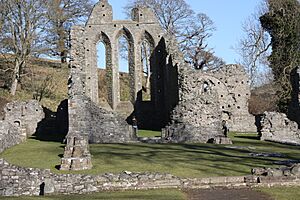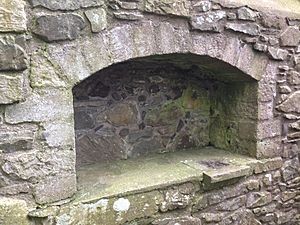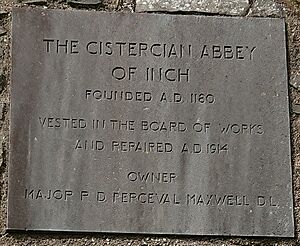Inch Abbey facts for kids
Inch Abbey is a big, ruined old monastery near Downpatrick in Northern Ireland. It sits by the River Quoile, surrounded by hills called drumlins. This amazing place shows off early Gothic architecture. Most of the site is looked after by the government.
Contents
History of Inch Abbey
Early Beginnings: Before the Normans
Long ago, this place was an island in the Quoile Marshes. An early Celtic monastery, called Inis Cumhscraigh, was here by the year 800.
In 1002, Vikings attacked the settlement. They were led by Sitric, King of the Danes. They sailed up the River Quoile from the sea. The Vikings attacked and robbed the monastery again in 1149.
We know about a large earth wall and ditch that surrounded this early monastery. You can still see parts of it today. The first buildings here were probably made of wood.
The Normans Build a New Abbey
Inch Abbey was started as a Cistercian monastery by John de Courcy and his wife, Affreca. John de Courcy built it to make up for destroying another abbey nearby in 1177.
Monks from Furness Abbey in England came to live here in 1180. Some monks from the destroyed Erinagh Abbey also joined them. The Cistercian monastery was built close to the river.
What You Can See at Inch Abbey
The Church and Its Design
The main church was built around 1200. It was shaped like a cross, which is called a cruciform plan. It had a low tower in the middle. The church was about 170 feet long.
The church had a main hall (called a nave) and two side sections (called transepts). Each transept had two small chapels.
East Window and Chancel
Today, only the impressive east window remains. The wall at the east end of the church, called the chancel, has three tall, pointed windows. The middle one is 23 feet high! This area was where the main altar was placed.
In the south wall of the chancel, you can see the remains of three seats for priests, called a sedilia. There is also a piscina, which was a basin used for washing altar items.
Transepts and Monk's Cemetery
Each transept chapel had its own altar. In the north transept, there was a door leading to the monk's cemetery. You can also see special marks carved into the stone walls. These are called mason's marks, made by the builders.
The Cloister and Other Buildings
The church is north of the cloister. A cloister is an open courtyard surrounded by covered walkways. Around the cloister were rooms for the monks. These rooms were used for meetings, working, sleeping, eating, and storage.
You can still see the foundations of the dining hall (refectory) and kitchen. These were along the south side of the cloister. There were also other buildings closer to the river. These included a place for sick monks (infirmary) and a bakehouse with two ovens. A well was also nearby.
Changes Over Time
The community of monks at Inch Abbey was probably never very large. This might be why they decided to make the church smaller later on.
In the 15th century, the church was changed. They walled off parts of it, making a much smaller church. The rest of the building was no longer used. The covered walkways around the cloister have disappeared.
Much of the detail you see in the chancel today is made of cement. This is because the original sandstone had worn away. It was restored in the 1800s.
Later History and Closure
Inch Abbey was a wealthy monastery for its time. In 1380, the government tried to make sure only English or "Anglicised" Irish monks lived there.
Twenty-four years later, the abbey was burned. This, along with a possible collapse of the central tower and fewer monks, led to the church being made smaller. Monastic life continued, but on a small scale.
By 1541, the abbey was closed down. The land, about 850 acres, was given to Gerald, the Earl of Kildare.
Discoveries from Excavations
Pieces of old pottery were found in a field north of the abbey graveyard. In 1983, archaeologists dug at the abbey. They found a carved stone from the 12th century. This stone might mean there was an earlier stone church on the site before the current ruins.
Inch Abbey Railway Station
Inch Abbey even has its own railway station! It opened in 2005 and is about 200 meters from the abbey.
The station is the end point of the Downpatrick and County Down Railway's North Line. You can visit the station on special days like St. Patrick's Day, Easter, bank holidays, and summer weekends. You can even ride a heritage steam or diesel train to Downpatrick town!




